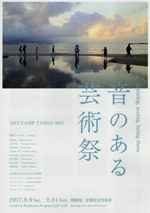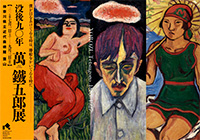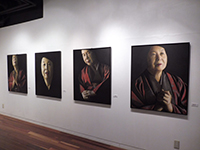 |
Picks is a monthly sampling of Japan's art scene, offering commentary by a variety of reviewers about exhibitions at museums and galleries in recent weeks, with an emphasis on contemporary art by young artists. |
 |
 |
 |
1 September 2017 |
 |
| 1 | 2 | |
 |
|
 |
 |
|
|
|
|
 |
 |
 |
 |
|
| Art Camp Tango 2017: listening, seeing, being there |
| 9 - 24 September 2017 |
Former Go Elementary School and other venues
(Kyoto) |
 |
| Art Camp Tango is a group of local artists and volunteers living in the city of Kyotango in northern Kyoto Prefecture on the Tango Peninsula, facing the Sea of Japan. Since 2014 it has held events that focus on artistic expression "through or related to sound," spanning the genres of contemporary art, music, sound art, and dance. This month's festival brings together artists from Japan and abroad in a promising effort to engage the region in sustained dialogue with the world at large. |
|
|
|
|

|
 |
 |
|
|
|
 |
 |
| YOROZU Tetsugoro 1885-1927 |
| 1 July - 3 September 2017 |
The Museum of Modern Art, Kamakura & Hayama
(Kanagawa) |
 |
| Commemorating the 90th anniversary of the artist's death, this massive show offered up a rather unheard-of volume of work: 442 items altogether, including 131 oils, 157 watercolors, sketches and prints, and 75 sumi ink paintings. Yorozu is known as a pioneer in Japanese modern art, but the skill with which he wielded the traditional sumi brush threatens to upend that image -- and with it the entire premise of the "modern artist." He was nothing if not a maverick. |
|
|
|
|
 |
 |
 |
| Sei Senkoji: Mother |
| 4 - 9 July 2017 |
Y Art Gallery
(Osaka) |
 |
| A collection of portraits of the artist's mother, an elderly lady dressed in kimono, her face strongly highlighted. They are dramatic compositions, straightforward yet sensitive to the interplay of light and darkness. They also depart radically from the dynamic drawings with sumi ink of Senkoji's past shows. Lately, it turns out, he has been engaged in a portraiture project focusing on one subject at a time. In that sense he continues to pursue the same overarching theme, the human figure.
|
|
|
|
|
|
|
 |
 |
| Record Extraordinaire! Uzo Nishiyama's Notebooks on Houses and Living |
| 9 June - 22 August 2017 |
LIXIL Gallery Osaka
(Osaka) |
 |
| An exploration of the extensive research materials preserved from the architectural scholar's studies of urban housing. Beginning in his graduate school days, Nishiyama (1911-94) not only worked as an architect but also carried out his own fieldwork on foot with the aim of developing a "scientific and socially-oriented approach" to housing. The sketches he drew in an effort to capture the lifestyles of ordinary citizens from every angle reveal a "modernological" outlook.
|
|
 |
|
|
|
 |
|
|